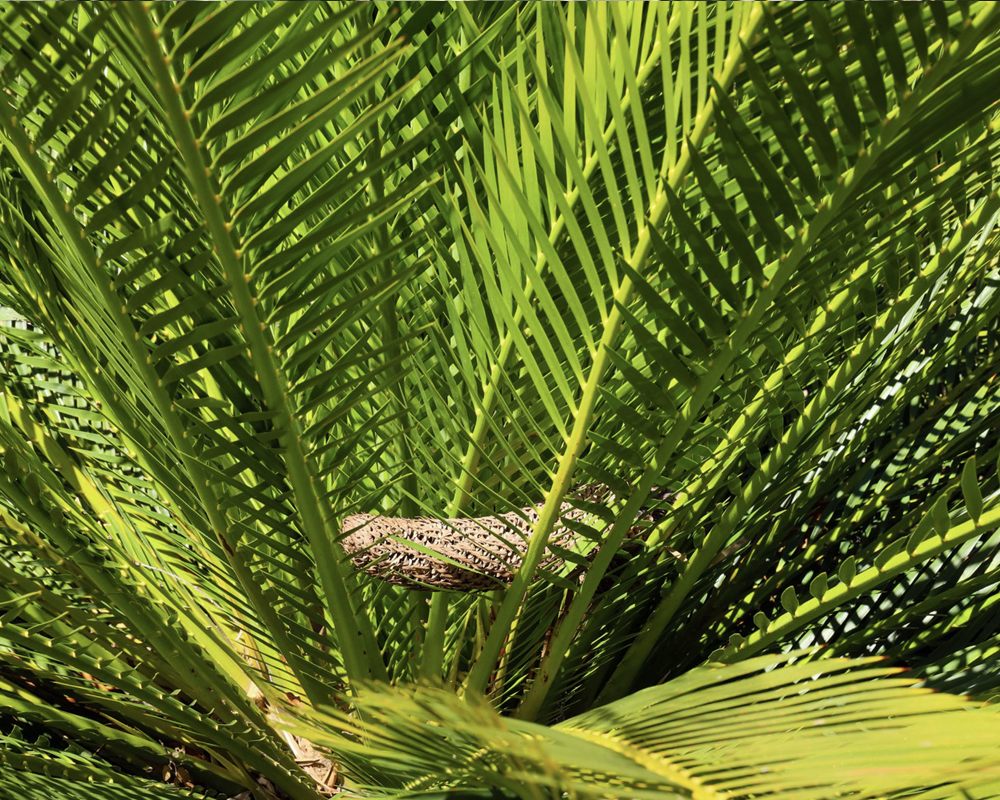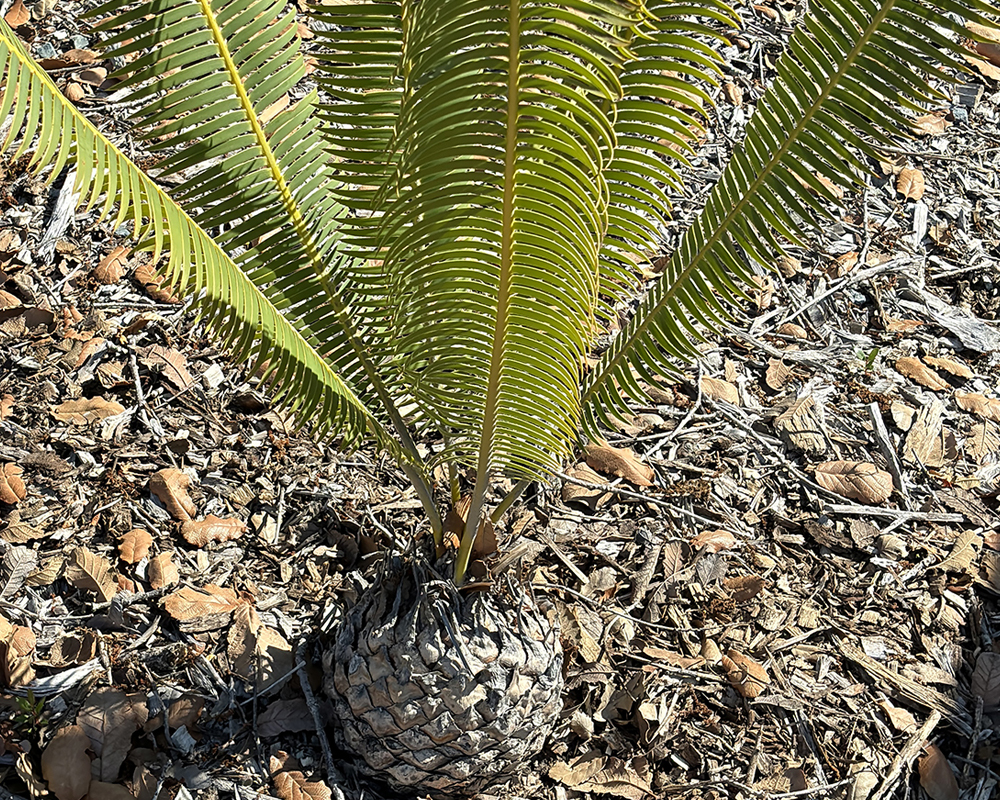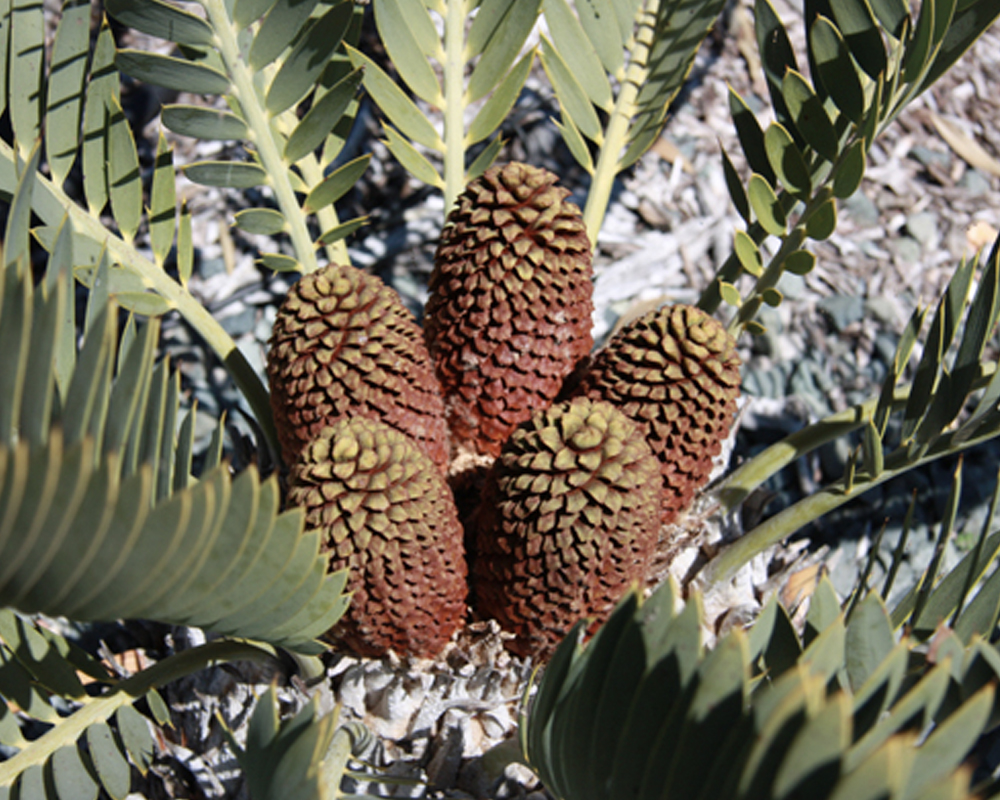
Cycads
The Garden’s cycad collection is one of the most comprehensive in the world. Many Cycads are extremely rare in habitat, due to their limited ranges, complex reproductive biology, and their status among collectors, it is crucial that we take every possible measure to ensure their continued survival.
Cycads are an ancient group of cone-bearing seed plants. They are older than flowering plants and pre-date the dinosaurs. The Garden grows nearly half of all known species, including many that are extinct or endangered in the wild. Today, cycads are threatened with extinction because of illegal collection, habitat destruction, and loss of pollinators.
Cycads are the most primitive of surviving gymnosperms, or cone-bearing plants, with palm-like leaves and a thick soft stem of storage tissue, mostly lacking any true wood. Their fossil record dates back to the early Mesozoic – about 250 million years. Their resemblance to palms or tree ferns ends when the plants produce cones. These cones resemble somewhat the cones of their relatives, the conifers, but they are generally larger. Cycads are dioecious, meaning that each plant has either female or male cones. Tropical and subtropical in distribution, cycads are found naturally in warmer regions of North and South America, Africa, Asia, and Australia.
The Garden grows cycads in the Virginia Haldan Tropical House and other greenhouses, along with a range of hardier species grown out-of-doors in collections throughout the Garden. Surrounding the Conference Center, the Cycad and Palm Garden represents one of the Garden’s few taxonomic outdoor collections. A Mexican cycad display can be seen adjacent to Julia Morgan Hall, as well as in the Mexican/Central American Collection.
Along with the rest of the Garden’s collection, cycads serve as a teaching and research resource at UC Berkeley and other universities around the world.
Looking for a specific cycad? Check our plant database.
Cycad Reproduction
The cycad reproductive cycle involves cones, not flowers, with the individual cone-bearing plants being either male or female. The male cones produce the pollen, are short-lived and decay after the pollen is shed. For pollination, cycads require insects (often weevils) to travel between the male and female plants.
Push-pull pollination
Although not well understood, the mechanism for cycad pollination is described as “push-pull” and occurs during daily periods of peak thermogenesis (the process of heat production in organisms) coinciding with the emission of volatile compounds (scent) from both the male and female cones. In the “push” scenario, pollen-laden insects are driven from the male cycad cones en masse, as contrasted with the “pull” scenario where volatile compounds are produced by the female cones, attracting the pollen-laden beetles, resulting in pollination.
Partnerships
The Plant Collections Network and the Global Conservation Consortium for Cycads
The University of California Botanical Garden at Berkeley (UCBG) is part of the Cycad Multisite Collection of the Plant Collections Network (PCN). The PCN is a joint program of the American Public Gardens Association and the USDA’s Agricultural Research Service. The program recognizes excellence in plant germplasm preservation and plant collections managment.
The Garden is also a participant in the Global Conservation Consortium for Cycads, an international effort to coordinate cycad conservation, with an emphasis on preventing extinction in the wild.
Collection Highlights
Our goal at the Garden is to represent the broadest diversity of taxa possible to support research, teaching, and conservation. Although many of our cycads are missing provenance data (having come from government confiscations) their taxonomic breadth makes them ideal for some avenues of research and for some conservation projects. Nearly 650 cycad accessions of just over 100 species are represented in the collection, including all ten genera. The three best represented genera are Macrozamia from Australia (39% of known taxa), Dioon from Mexico (55% percent of known taxa), and Encephalartos (60% of known taxa). San Francisco Bay Area temperatures are ideal for many Encephalartos, including the taxa that are the focus of our conservation effort, and the monotypic genus Stangeria, found in the Virgina Haldan Tropical House. Our climate is marginal for the Central and South American taxa from the genus Zamia. The species in the Mexican genera Dioon and Ceratozamia have prospered and coned outdoors in the Garden. We have a relatively large number of cycads not fully hardy in the San Francisco Bay Area, such as the beautiful and exotic looking Cycas multipinnata and C. bifida. These, along with the genera Microcycas and Bowenia, require greenhouse care here. Tissue samples continue to be supplied for various research projects and frozen pollen is shared with other collection holders for controlled breeding.
History
Cycads have been a part of the Garden collection since the late 1930s. The oldest living cycad in our collection is a sago palm (Cycas revoluta) that was accessioned as a plant in 1950 (an exchange from the Huntington Botanical Gardens). While not the oldest accession at the Garden, that distinction goes to a 1928 accession of Afrocarpus gracilior in the Southern African Area, it is a venerable specimen.
In 2002 the Garden contracted with the US Fish and Wildlife Service (USFWS) to care for about 1,000 cycads, obtained as part of an elaborate sting (called “Operation Botany”) of an illegal importation, chronicled in a New York Times Magazine article that ran on August 28, 2005. Not all of the plants survived the smuggling process, and it took up to four years for some of them to finally leaf out from a dormant state. At the end of the ensuing prosecutions about 700 plants were turned over to the Garden in its capacity as a Plant Rescue Center for the USFWS. Confiscated plants came from several locations in Africa (mainly South Africa) and Asia, as well as from Australia and Mexico. This donation greatly expanded the cycad holdings of the Garden, more than doubling the number of taxa and adding five times the number of accessions previously held.
Our cycad holdings, and particularly the plants derived from the confiscation, represent a major and exciting collection, and a significant responsibility for the Garden. The majority of confiscated plants were in all likelihood removed from the wild by poachers, resulting in a serious drain on already imperiled populations. Cycads are slow to reproduce and often limited in distribution. A number of the southern African taxa we received are very rare in the wild and almost non-existent in botanical garden collections.
Conservation and Research
While the Garden’s cycad collection displays broad taxonomic diversity, as part of the Plant Collections Network we designate our holdings as a conservation-based collection with a focus on genetic diversity. With forty species held, the genus Encephalartos is the specific focus of our cycad breeding program. At least two taxa, Encephalartos hirsutus and Encephalartos middelburgensis, obtained from the confiscation are extremely rare in collections and now known to be extinct in the wild. These species, and at least two more in our collection, and four others have been declared extinct in the wild by the International Union for the Conservation of Nature’s Cycad Specialist Group. While the confiscated plants lack provenance, in all likelihood they were collected in the wild. Regardless, the Garden’s plants represent some of the last publicly held individuals of these taxa.
Garden staff members are working on collaborative conservation projects involving these and other rare cycad species. Cycads are long-lived and slow to reproduce. Species-specific pollinator insects (often weevils) are absent in our area. We are conducting an artificial breeding program with a goal of producing propagules for future reintroduction into the wild. Pollen from all rare cycad taxa is collected and frozen for future use. Within our collection certain species are quite numerous and have begun to cone regularly. We have successfully pollinated C. bifida, D. tomasellii, E. horridus , E. trispinosus, middelburg cycad (E. middleburgensis), and Waterbury cycad (E. eugene-maraisii) to produce seedlings. Our pollination techniques are undergoing refinement, and we are growing on the first young plants from our breeding efforts.
The UC Botanical Garden was founded as and continues to be a research collection. Although the cycads are not replete with provenance data, their taxonomic breadth makes them ideal for some avenues of research. Among other projects , former UCB faculty member Dr. Chelsea Specht and her then graduate student Chodon Sass and colleagues explored the possibilities of DNA barcoding within cycads.
Research Publications to Date
Ellstrand, Norman C., Robert Ornduff, and Janet M. Clegg. 1990. Genetic structure of the Australian cycad, Macrozamia communis (Zamiaceae). American Journal of Botany 77 (5): 677-681.
Ornduff, Robert. 1996. Gender performance in a cultivated cohort of the cycad Zamia integrifolia (Zamiaceae). American Journal of Botany 83 (8): 1006-1015.
Sass, Chodon, Damon P. Little, Dennis Wm. Stevenson, and Chelsea D. Specht. 2007. DNA barcoding in the Cycadales: Testing the potential of proposed barcoding markers for species identification of cycads. PLoS ONE. 2 (11): e1154. doi:10.1371/journal.pone.0001154.
Schneider, Edward L., Sherwin Carlquist, and Jeffrey G. Chemnick. 2007. Scanning electron microscope studies of cycad tracheids. South African Journal of Botany 73 (4): 512-517.
Additional Resources
The Cycad Specialist Group (a member of the International Union for Conservation of Nature Species Survival Commission)
Banner photo: Encephalartos senticosus


